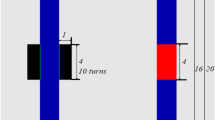Abstract
Finite Element Method Magnetics (FEMM) is an open source finite element analysis software package for solving electromagnetic problems. The program addresses 2D planar and 3D axisymmetric linear and nonlinear harmonic low frequency magnetic and magnetostatic problems and linear electrostatic problems. It is a simple, accurate, and low computational cost freeware product, popular in science and engineering. However its educational value has been underestimated. Use of the package in education is quite rare. The aim of this paper is to explore the capability of FEMM to meet as a complementary tool the needs of teaching electromagnetics in higher education. In order to demonstrate its use and exhibit the aid it offers in the teaching of electromagnetics illustrative examples are given. Evaluations in both qualitative and quantitative data have also been conducted and presented. Useful conclusions about its usage and potential applications in the teaching of electromagnetics in higher education are finally drawn.















Similar content being viewed by others
References
Acuña, M. H., et al. (2002). Near magnetic field observations at 433 Eros: First measurements form the surface of an asteroid, Icarus 155, Elsevier Science, pp. 220–228.
Balanis, C. A. (1989). Advanced engineering electromagnetics. USA: Willey.
Boniface, C., et al. (2005). A Monte-Carlo study of ionization processes in double stage Hall effect thruster, Proceedings of the XXVIIth ICPIG, topic 19, Eindhoven, The Netherlands.
deMarrais, K., & Lapan, S. D. (eds.) (2004), Evaluation studies in foundations for research: methods of inquiry in education and the social sciences. Manwah: Erlbaum.
Gorman, M. E. Ryan, et al. (eds.) (2005). Scientific and technological thinking. USA: Erlbaum.
Hoole, S. R. (1989). Computer-aided analysis and design of electromagnetic devices, Elsevier.
Ierusalimschy, R. (2006). Programming in Lua, 2nd ed., Biblioteca do Departamento de Informática.
Íñiquez, J., et al. (2005). Magnetic levitation by induced eddy currents in non-magnetic conductors and conductivity measurements. European Journal of Physics, 26, 951–957. doi:10.1088/0143-0807/26/6/002.
Lee, Y. S., Kim, G., et al. (2006). Development of a neutron polarizer 3He spin filter at the Pohang neutron facility. Journal of the Korean Physical Society, 48(2), 233–239.
Macías-Guarasa, J., et al. (2006). A project-based learning approach to design electronic systems curricula. IEEE Transactions on Education, 49(3), 389–397. doi:10.1109/TE.2006.879784.
Meeker, D. (2004a). Finite element method magnetics: User’s manual, 4th ver.
Meeker, D. (2004b). FEMM 4.0 Electrostatics Tutorial.
Moaveni, S. (1999), Finite element analysis: Theory and application with ANSYS. Prentice-Hall.
Pamme, N. (2006). Magnetism and microfluidics. Lab on a Chip, 6, 24–38. doi:10.1039/b513005k.
Papert, S. (1978). The children’s machine: Rethinking school in the age of the computer. Basic Books.
Piaget, J. (1975). Equilibration of cognitive structures. Univ. of Chicago Press.
Picker, R. (2004). A new superconducting magnetic trap for ultra-cold neutrons. Germany: Diploma thesis, Technische Universität München.
Roberts, T. S. (2005). Computer-supported collaborative learning in higher education. Idea Group.
Rotariu, O., et al. (2005). Targeting magnetic carrier particles in tumor microvasculature—A numerical study. Journal of Optoelectronics and Advanced Materials, 7(6), 3209–3218.
Vallim, M. B. R., et al. (2006). Practicing engineering in a freshman introductory course. IEEE Transactions on Education, 49(1), 74–79. doi:10.1109/TE.2005.856157.
Volakis, J. L., et al. (1998). Finite element methods for electromagnetics. IEEE.
Vygotsky, L. S. (1978). Mind in society: The development of higher psychological processes. Harvard Univ. Press.
Wichert, T., & Kub, H. (2005). Design and optimization of switched reluctance machines. Poland: Proceedings of the XLI International Symposium on Electrical Machines Jun. 2005.
Zandsteeg, C. J. (2005). Design of a robocup shooting mechanism, Report 2005.147. The Netherlands: Eindhoven University of Technology.
Author information
Authors and Affiliations
Corresponding author
Rights and permissions
About this article
Cite this article
Baltzis, K.B. The finite element method magnetics (FEMM) freeware package: May it serve as an educational tool in teaching electromagnetics?. Educ Inf Technol 15, 19–36 (2010). https://doi.org/10.1007/s10639-008-9082-8
Published:
Issue Date:
DOI: https://doi.org/10.1007/s10639-008-9082-8




